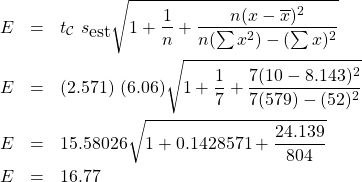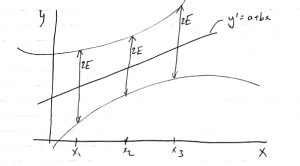14. Correlation and Regression
14.7 Confidence Interval for y′ at a Given x
At a fixed ![]() (that is important to remember) the confidence interval for
(that is important to remember) the confidence interval for ![]() is
is
![]()
where
![Rendered by QuickLaTeX.com \[ E = t_{\cal{C}} \; s_{\mbox{est}} \sqrt{1+ \frac{1}{n} + \frac{n(x - \overline{x})^{2}}{n(\sum x^{2})-(\sum x)^{2}}} \]](https://openpress.usask.ca/app/uploads/quicklatex/quicklatex.com-8eeb4fe78d300cc187a7dc10924b97f7_l3.png)
where, as usual, ![]() comes from the t Distribution Table with
comes from the t Distribution Table with ![]() .
.
Example 14.5 : Continuing from Example 14.4 (so you can see how an exam will go), say we want to predict the grade (![]() ) in terms of a 95
) in terms of a 95![]() confidence interval for the number of absences (
confidence interval for the number of absences (![]() ) equal to 10.
) equal to 10.
First, find the value predicted from the regression line, which we previously found to be :
![]()
at ![]() . The result is
. The result is
![]()
Furthermore, from the last example, we found
![]()
and, from the completed data table (Example 14.3)
![]()
We still need ![]() and
and ![]() . Using our sums:
. Using our sums:
![]()
and from t Distribution Table for the 95![]() confidence interval,
confidence interval, ![]() we get
we get
![]()
Now we compute ![]() :
:

So

This is the 95![]() confidence interval for predicting the mark of a person who was absent for 10 days.
confidence interval for predicting the mark of a person who was absent for 10 days.
▢
Important: ![]() is independent of
is independent of ![]() but
but ![]() is not. So confidence intervals look like :
is not. So confidence intervals look like :

The reason for this variance of the width of the confidence interval comes from the uncertainty in the slope ![]() . You can make plots like the one above in SPSS.
. You can make plots like the one above in SPSS.

